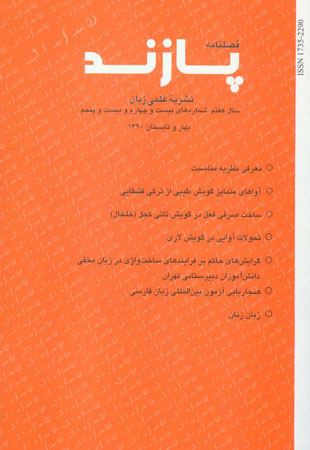فهرست مطالب

فصلنامه پازند
پیاپی 24-25 (بهار و تابستان 1390)
- 126 صفحه، بهای روی جلد: 20,000ريال
- تاریخ انتشار: 1390/11/15
- تعداد عناوین: 7
-
صفحه 5
-
صفحه 47
-
صفحه 101
-
Page 5Relevance theory tries to represent the Maxims of Grice (1989) and this issue that main characteristics of most human relationships are to recognize purposes. Grice established an inferentialcommunicative model. The aim of which is to indicate how the reader can infer the speaker meaning. Wilson Sperber(1986) introduced relevance theory which is originated Grice's viewpoints, with two cognitive and communicative devices.Keywords: relevance theory, utterance, decoding, Grice cooperative principles, pragmatics
-
Page 15This paper is an attempt to introduce distinguishing phones of Tayebi dialect of Qashqay. One of the significant features of this dialect is the effect of Persian language on it. The data were collected through recorded interviews with a community of fifteen native speakers of this Turkish dialect. Dialect analysis of the variety under the investigation, at the phonetic level has resulted in a comprehensive list of the sound types which is considered a rich resource to extract different phones of Tayebi dialect of Qashqay.Keywords: torki of Qashqay, tayebi dialect, nasal hard palate
-
Page 27The Tati of Kajal is one of the north western dialects of Iran which keeps its ancient characteristics. These characteristics, distinguishes the dialect of Kajal from Persian language. Among different characteristics of this dialect are: ablaut in a few verbs, the ergative structure, the passive voice, grammatical gender, case and etc.Keywords: root, passive voice, infinitive, verb affixes, ergative structure
-
Page 47This paper explores the historical changes of vowels and consonants in Lari dialect spoken in Larestan in the south of Fars province. The most important changes of consonants including deletion, assimilation, lenition, etc. are studied and compared with similar processes in old Iranian languages as well as Middle and Modern Persian. Moreover, some phonological processes such as compensatory lengthening and adaptation of loan sounds in this dialect are dealt with. Some types of vowel changes like fronting and shortening are presented too. The findings of this paper shows that the pace of sound changes in this dialect is far more rapid than its sister language, Modern Persian. Indeed, the homogeneity resulting from standardization decreases the speed of changes in language. Lari dialect, lacking any standard or written form, has been profoundly changed in the absence of such constraints.Keywords: Lari dialect, Sound changes, Modern Persian
-
Page 65This paper tries to find the dominant word formation processes with the highest frequency in the current argot among Tehran's high school students. We presented Richards’ and Schmidt’s (2002) and Hudson’s (2000) viewpoints about word formation in the standard language; afterwards, we examined the content of "a Persian dictionary of argot" containing approximately 510 words and expressions. Our findings are as follows:• First, Compounding is placed at the top of the other processes.• Second, there is usage of some suffixes in the Argot which are known as frozen suffixes in the standard Persian language.• Last, "Argot is a part of standard language" said Samai; nevertheless, there are two kinds of suffixes in derivation which are not in agreement with the main word formation processes in the standard Persian language:1- Usage of borrowed suffixes from Arabic language to determine different sexes.2-Usage of suffixes with no history in Persian language, which may be derived in the surveyed Argot by wrong cutting.Keywords: Argot, Word formation Processes, Adding Affixes, Phonological Treatment, Persian
-
Page 87The goal of this survey is to find the norms for the International Persian LanguageTest in Iran. Therefore, for the first time, in Iran Language Institute, a group of the authors created a standard test. This test includes the three skills of listening, grammar, and reading and vocabularies. It totally contains 100 questions and 100 scores. This test became performed for a group of 50 foreigners who were learning Persian in the intermediate level in Dehkhoda Institution, Shahed University, and Al-Mahdi School of Qom. In following, the questions which had a low correlation coefficient with the other questions of that part became analyzed. As well, the cronbach's alpha for each skill was (Listening: 0.814, Grammar: 0.816, Reading & vocabularies: 0.913) and for all the questions was 0.945, which showed an appropriate stability for this test.Keywords: Farhad Shaghaghi, Bahman Zandi, Neda Matani
-
Page 101In this paper language and gender is studied to understand whether the notion of "women’s language" exists? To do this, first the results of research on gender differences in speech styles are briefly mentioned. Then the rate of men and women’s speech power is examined in terms of some linguistic features and finally, considering the stated contradictions, absence of a direct relationship between the linguistic form and it’s communicative function and the definition of gender as a set of discourses or ideological constructs, the answer to the above question is put forward.Keywords: language, gender, speech style, cotrudiction

